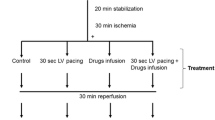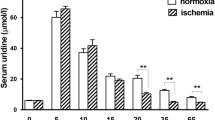Summary
Successive ischemic episodes are commonly seen in clinical and experimental cardiology. Although prolonged abnormalities of the canine myocardium have been described following a single ischemic episode, it is not known whether myocardial injury is cumulative following multiple ischemic episodes. Dogs were subjected to three 15-min left anterior descending coronary artery occlusions, each followed by 30 min of reperfusion.In vivo biopsies were obtained for biochemical analysis before and during the first occlusion and 30 min into each reperfusion period. ATP and creatine phosphate (CP) fell in the endocardium during occlusion by 24% and by 69% respectively (both p<.0001). While CP recovered during each reperfusion period, ATP remained significantly depressed. Loss of membrane-permeable purine nucleotide synthesis precursors occurred with the first reperfusion period but not with the second and third reperfusion periods. Therefore, reperfusion following one 15-min coronary occlusion is associated with severe depression of myocardial high energy phosphates; however, two additional occlusions do not cause a further decrease of these substances when intermittent reperfusion is allowed for 30 min.
Similar content being viewed by others
References
Berne RM, Rubio R (1974) Adenine nucleotide metabolism in the heart. Circ Res 34–35:111
Braunwald E, Kloner RA (1982) Editorial: The stunned myocardium — prolonged, post-ischemic ventricular dysfunction. Circulation 66:1146
Buckberg GD, Luck JC, Payne B, Hoffman JIE, Archie JP, Fixler DE (1971) Some sources of error in measuring regional blood flow with radioactive microspheres. J Appl Physiol 31:598
DeBoer LWV, Ingwal JS, Kloner RA, Braunwald E (1980) Prolonged derangements of canine myocardial purine metabolism following a brief coronary artery occlusion not associated with anatomic evidence of necrosis. Proc Natl Acad Sci USA 77:5471
Fallon JT (1979) Simplified method for histochemical demonstration of experimental myocardial infarct. Circulation 60(2):11
Fishbein MC, Meerbaum S, y-Rit J, Lando U, Kanmatsuse K, Mercier JC, Corday E, Ganz W (1981) Early phase acute myocardial infarct size quantification: Validation of the triphenyltetrazolium chloride tissue enzyme staining technique. Am Heart J 101:593
Fox AC, Reed GE, Meilman H, Silk BB (1979) Release of nucleosides from canine and human hearts as an index of prior ischemia. Am J Cardiol 43:52
Geft IL, Fishbein MC, Ninomya K, Hashida J, Chanx E, Yano J, Y-Rit J, Genov T, Shell W, Ganz W (1982) Intermittent brief periods of ischemia have a cumulative effect and may cause myocardial necrosis. Circulation 66:1150
Gerlach E, Deuticke B, Dreisbach RH (1963) Der Nucleotid-Abbau im Herzmuskel bei Sauerstoffmangel und seine mögliche Bedeutung für die Koronardurchblutung. Naturwissenschaften 50:228
Hillis LD, Khuri SF, Braunwald E, Kloner RA (1979) Assessment of the efficacy of interventions to limit ischemic injury by direct measurement of intramural carbon dioxide tension after coronary artery occlusion in the dog. J Clin Invest 63:99
Jacobus WE, Lehninger AL (1973) Creatine kinase of rat mitochondria. Coupling of creatine phosphorylation to electron transport. Biol Chem 248:4803
Jennings RB, Hawkins HK, Lowe JE, Hill ML, Klotman S, Reimer KA (1978) Relation between high energy phosphate and lethal injury in myocardial ischemia in the dog. Am J Pathol 92:187
Katori M, Berne RM (1966) Release of adenosine from anoxic hearts. Circ Res 19:420
Kloner RA, Ellis SG, Lange R, Braunwald E (1983) Studies of experimental coronary artery reperfusion. Effects on infarct size, myocardial function, biochemistry, ultrastructure and microvascular damage. Circulation 68:I-8
Lange R, Ware J, Kloner RA (1984) Absence of a cumulative deterioration of regional function during three repeated 5 or 15 min coronary occlusions. Circulation 69:400
Lie JT, Pairolero PC, Holley KE, Titus JL (1975) Macroscopic enzyme-mapping: Verification of large, homogeneous, experimental myocardial infarcts of predictable size and location in dogs. J Thorac Cardiovasc Surg 69:599
Lowry OH, Passoneau JB (1972) A flexible system of enzymatic analysis. Academic Press, New York, p 151
Lowry OH, Rosebrough MJ, Farr AL, Randall RJ (1951) Protein measurement with the Folin phenol reagent. J Biochem 193:265
Reibel DK, Rovetto MJ (1978) Myocardial ATP synthesis and mechanical function following oxygen deficiency. Am J Physiol 234(5):H620
Reimer KA, Lowe JE, Rasmussen MM, Jennings RB (1977) The wavefront phenomenon of ischemic cell death. Circulation 56(5):786
Reimer KA, Hill ML, Jennings RB (1981) Prolonged depletion of ATP and of the adenine nucleotide pool due to delayed resynthesis of adenine nucleotides following reversible myocardial ischemic injury in dogs. J Mol Cell Cardiol 13:229
Sandritter HW, Jestaedt R (1958) Triphenyltetrazoliumchlorid (TTC) als Reduktionsindikator zur makroskopischen Diagnose des frischen Herzinfarktes. Verh Dtsch Ges Pathol 41:165
Swain JL, Sabina RL, McHale PA, Greenfield JC Jr, Holmes EW (1982) Prolonged myocardial nucleotide depletion after brief ischemia in the open-chest dog. Am J Physiol 242:H818
Tzafologg A (1982) Mitochondrial structure and compartmentalization. In: Cell organelles (Siekevitz P ed) p 15 (Plenum Press, New York)
Wallenstein S, Zucker CL, Fleiss JL (1980) Some statistical methods useful in circulation research. Circ Res 47:1
Zimmer HG, Trendelenburg C, Kammermeier H, Gerlach E (1973) De novo synthesis of myocardial adenine nucleotides in the rat. Circ Res 32:635
Author information
Authors and Affiliations
Additional information
Supported in part by Grants HL 23140, 28048 and SCOR 26215 under the National Heart, Lung and Blood Institute, Bethesda, Maryland
This work was done during the tenure of Drs. Kloner and Ingwall as Established Investigators from the American Heart Association and with funds contributed in part by the Massachusetts Heart Association.
Rights and permissions
About this article
Cite this article
Lange, R., Ingwall, J.S., Hale, S.L. et al. Effects of recurrent ischemia on myocardial high energy phosphate content in canine hearts. Basic Res Cardiol 79, 469–478 (1984). https://doi.org/10.1007/BF01908148
Received:
Issue Date:
DOI: https://doi.org/10.1007/BF01908148




